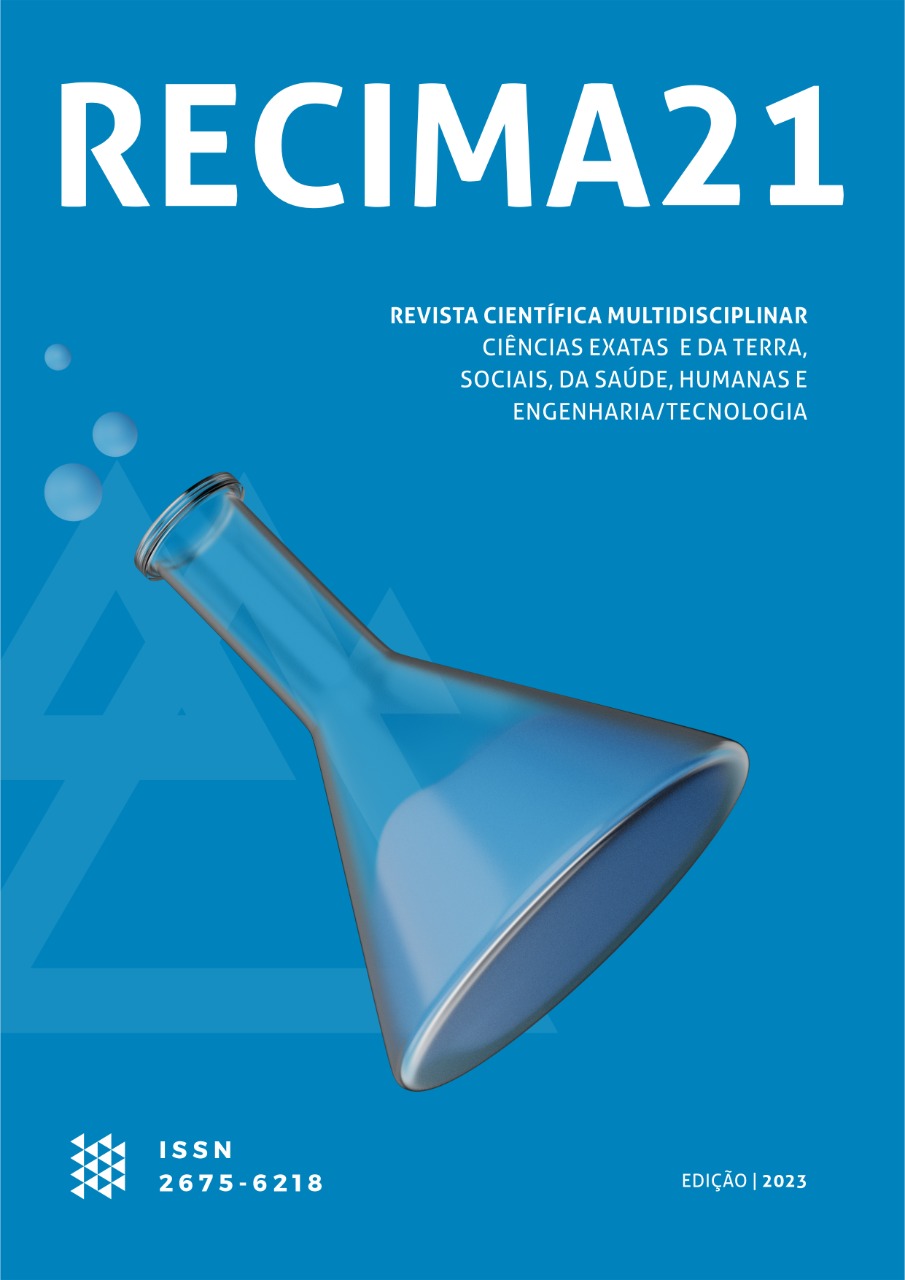ESTUDO SOBRE A LEISHMANIOSE NO MUNICÍPIO DE CARLOS CHAGAS (MG) E AS PRINCIPAIS CONSEQUÊNCIAS DE SUA CONTAMINAÇÃO NA POPULAÇÃO ANIMAL
DOI:
https://doi.org/10.47820/recima21.v4i11.4504Palavras-chave:
Leishmaniose Visceral, Saúde Pública, epidemiologiaResumo
Este artigo abordou a temática leishmaniose visceral canina (LVC), uma doença parasita e endêmica, que pode ser fatal para alguns animais e para pessoas. Ela é gerada pelo Leishmania Chagasi, que transmitido através do repasto sanguíneo de um inseto chamado flebotomíneo (Lutzomvia longipalpis), popularmente conhecido como mosquito palha. A doença vem tomando enormes proporções no Brasil, sendo considerada uma doença de saúde pública. Além da revisão de literatura, realizou-se pesquisa de campo de abordagem quantitativa. O estudo teve como objetivo analisar o índice de leishmaniose no município de Carlos Chagas - MG, apresentando como o município tem lidado com esta endemia, destacando dados quantitativos sobre os casos de leishmaniose com o foco no município supracitado. A pesquisa foi realizada Setor do Controle de Endemias do município. Os resultados apontam que houve um crescimento ao decorrer dos anos citados na pesquisa, além de outras observações presentes no estudo. Observou-se que em 2021, os amimais reagentes ao teste DPP® foram de 32,42%, em 2022, foram 39,74%. Contudo, em 2023 houve um declínio, apresentando um percentual de 27,95%, os testes feitos como contraprova apresentam o mesmo declínio dos testes reagentes em 2023. Por esse motivo, compreende-se que em todos os dados estatísticos apresentados no estudo, as porcentagens são mínimas em comparação aos outros anos. Nota-se a importância da prevenção, tendo como pleno envolvimento da saúde pública, ressaltando a participação direta do médico veterinário, que se faz indispensável em todos os processos que envolvem a doença, desde o diagnostico até a prevenção.
Downloads
Referências
ALBUQUERQUE, A. L. H.; LANGONI, H. A prática do tratamento na Leishmaniose visceral canina (LVC) em clínicas veterinárias, cuidados e protocolos. Vet. E Zootec., v. 25, n. 1, p. 132-141, jun. 2018.
ALVAR, J.; MOLINA, R.; SAN ANDRÉS, M.; TESOURO, M.; NIETO, J.; VITUTIA, M.; GONZÁLEZ, F.; SAN ANDRÉS, M.D.; BOGGIO, J.; RODRIGUEZ, F.; SÁINZ, A.; ESCACENA, C. Canine leishmaniasis: clinical, parasitological anda entomological follow-up after chemotherapy. Annals of Tropical Medicine and Parasitology, v. 88, p. 371- 378, 1994.
BADARÓ, R.; REED, S. G.; CARVALHO, E. M. Immunofluorescent antibody test in American visceral leishmaniasis: sensitivity and specificity of different morphological forms of two Leishmania species. The American Journal of Tropical Medicine and Hygiene, v. 32, n. 3, p. 480-84, 1983.
BRASIL. Leishmaniose Visceral. Brasília: Ministério da Saúde. Gabinete do Ministro, 2020.
BRASIL. Ministério da Saúde. Manual de vigilância e controle da Leishmaniose Visceral: normas e manuais técnicos. Brasília: Ministério da Saúde, 2003. 120p.
BRASIL. Nota Técnica n. 023/CPV/ DFIP/SDA/MAPA - publicada em 19 de setembro de 2008. Brasilia: Ministério da Agricultura, Pecuária e Abastecimento, 2008. Disponível em: http://www.sbmt.org.br/portal/wpcontent/uploads/2016/09/nota-tecnica.pdf.
BRASIL. Portaria Interministerial n. 1.426, de 11 de julho de 2008. Brasilia: Ministério da Saúde, 2008. Disponível em: http://bvsms.saude.gov.br/bvs/saudelegis/gm/2008/pri1426_11_07_2008.html.
CONSELHO FEDERAL DE MEDICINA VETERINARIA. Leishmaniose Visceral Canina. Brasília: CFMV, 15 maio 2021. Disponível em: https://www.cfmv.gov.br/perguntas-e-respostas-sobre-a-leishmaniose-visceral-canina-lvc-questoes-tecnicas-e-legais/transparencia/perguntas-frequentes/2018/10/26/. Acesso em: 31 out. 2023.
CONSELHO FEDERAL DE MEDICINA VETERINÁRIA. Resolução n. 1000 de 11 de maio de 2012, que dispõe sobre procedimentos para eutanásia de animais [Internet]. Brasília: CFMV, 2012 Disponível em: http://portal.cfmv.gov.br/lei/index/id/326.
FUNDAÇÃO OSWALDO CRUZ. Leishmaniose: Agência Fiocruz de Notícias. Rio de Janeiro: Fiocruz, 2013.
INIESTA, L. et al. Diagnostic techniques to detect cryptic leishmaniasis in dogs. Clinical and Diagnostic Laboratory Immunology, v. 9, n. 5, p. 1137-1141, 2002.
LOPES, Valquriria; VALE, João Henrique. Leishmaniose volta a crescer em Minas Gerais e já matou mais que dengue. Estado de Minas, 19 set. 2017.
MERGEN, Maria Eduarda; SOUZA, Marília Mascarenhas. Leishmaniose Visceral canina, métodos diagnósticos e tratamento na atualidade. Revisão de literatura. Revista JRG de Estudos Acadêmicos, v. 6, n. 13, p. 1024-1036, 2023.
MINISTÉRIO DA SAÚDE. Guia de Vigilância em Saúde: Volume 3. Brasília/DF: Ministério da Saúde, 2017.
SILVA, F. S. Patologia e patogênese da leishmaniose visceral canina. Revista Trópica – Ciências Agrárias e Biológica, v. 1, n. 1, p. 20, 2007.
SILVA, S. R. (Org.) Avaliação da infecciosidade em cães vacinados com Leish-Tec® (Hertape Saúde Animal S/A) para Lutzomyia longipalpis (Diptera: Psychodidae, Phlebotominae). Belo Horizonte: [s. n.], 2015.
TIZARD, I. R. Imunologia Veterinária: introdução. São Paulo: Editora Roca, 2014.
ZANINI, M.; VIEIRA ALMEIDA, Y.; SAVERGNINI POLEZE, L.; ISABELLE SILVA SOUZA, L. Avaliação sorológica de cães vacinados com vacinas comerciais contra leishmaniose visceral no município de Íuna-ES após um ano de vacinação. Pubvet, [S. l.], v. 13, n. 06, 2019. DOI: 10.31533/pubvet.v13n4a352.1-5. Acesso em: 12 nov. 2023.
Downloads
Publicado
Licença
Copyright (c) 2023 RECIMA21 - Revista Científica Multidisciplinar - ISSN 2675-6218

Este trabalho está licenciado sob uma licença Creative Commons Attribution 4.0 International License.
Os direitos autorais dos artigos/resenhas/TCCs publicados pertecem à revista RECIMA21, e seguem o padrão Creative Commons (CC BY 4.0), permitindo a cópia ou reprodução, desde que cite a fonte e respeite os direitos dos autores e contenham menção aos mesmos nos créditos. Toda e qualquer obra publicada na revista, seu conteúdo é de responsabilidade dos autores, cabendo a RECIMA21 apenas ser o veículo de divulgação, seguindo os padrões nacionais e internacionais de publicação.













